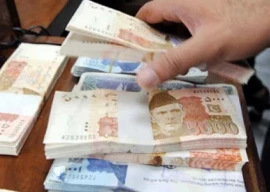
The government has initiated domestic debt re-profiling by repaying expensive short-term loans to commercial banks early and plans to raise low-cost, long-term debt due to increased availability of funds with the government. Additionally, rising liquidity in the system and the looming threat of additional taxes of up to 19% on banksif they fail to raise the advance-to-deposit ratio (ADR) to 50% by the end of December 2024 from the current 38%have led banks to offer new loans to private-sector businesses at KIBOR (Karachi Inter Bank Offered Rate) minus 6% in recent days.
According to data from the State Bank of Pakistan (SBP), the government has repaid Rs351 billion to commercial banks by buying back its short-term paper (market treasury bills or MTBs) from financial institutions on Monday. Then, on Tuesday, the Ministry of Finance announced plans to raise Rs10.10 trillion in new debt over the next three months (OctoberDecember 2024), partly by selling long-term Pakistan Investment Bonds (PIBs) with maturities ranging from 2 to 30 years, while heavily retiring short-term (3 to 12-month T-bills) debt.
Arif Habib Limited's economist, Sana Tawfik, told The Express Tribune that the government initiated domestic debt re-profiling after the availability of funds increased, thanks to the central bank transferring Rs2.7 trillion in profits to the government, in compliance with regulations for FY24. The re-profiling is aimed at reducing interest expenses and shifting the debt structure from short-term to long-term, to avoid frequent repayment pressures. The shift to long-term instruments will allow the government to better plan for increasing tax revenue collection and reducing reliance on debt.
Moreover, the premature repayment of debt to banks has increased liquidity in the system, which will encourage financial institutions to offer new financing to the government at reduced rates. The surplus liquidity has strengthened the government's position to borrow new loans at a lower cost. Previously, banks were offering financing at significantly higher rates.
A notable slowdown in inflation, which fell to a four-year low of 6.9% in Septemberbelow market expectations of around 7.5% to 8%is further increasing pressure on banks to offer loans at reduced rates, given that the central bank is expected to cut its benchmark policy rate by another 150 basis points in November.
In a commentary, Tawfik noted that in an unprecedented move, the government of Pakistan initiated a T-bill buyback programme on Monday, repurchasing Rs351 billion worth of T-bills against a target of Rs500 billion. This bold move is expected to strategically re-profile the government's debt, transitioning towards longer maturities and lowering debt servicing costs (interest payments). While global debt buyback programmes typically focus on "off-the-run" bonds with lower liquidity, Pakistan has opted to repurchase shorter-term instruments in its first buyback effort.
These T-bills, which are being repurchased, are set to mature in December 2024, a period marked by significant maturities totalling Rs4.6 trillion in T-bills. The timing of this move appears to have been driven by a recent liquidity boost, which is believed to be partly due to the Rs2.7 trillion transfer from the SBP. The buyback reflects a prudent approach to managing Pakistan's overall debt position. By retiring T-bills ahead of their maturity, the government is not only adjusting the debt profile from short-term to long-term but is also securing potential savings by reducing interest costs.
Tawfik estimates that this buyback could save the government Rs11.6 billion while easing the December 2024 debt obligations. By repurchasing these T-bills, the government will ease liquidity conditions for investorsprimarily banks, which are the largest holders of government securities. This influx of liquidity is expected to lead to more aggressive bidding in future government debt auctions, potentially pushing yields even lower and encouraging banks to shift their portfolios from short-term to long-term instruments.
New debt plan
The government has announced plans to raise Rs10.10 trillion by selling new T-bills and PIBs over the remaining three months of the year, according to the central bank. The auction calendar suggests that the government is aiming to raise Rs5.20 trillion through the sale of T-bills and another Rs4.90 trillion through the sale of PIBs. However, a significant portion of the new debt will be used to retire maturing short-term T-bills worth Rs8.82 trillion.
JS Global stated in a commentary that the anticipation of continued monetary easing is putting additional pressure on KIBOR rates. To meet the gross ADR requirement of at least 50% by the end of 2024 and avoid higher taxes, banks are focusing on securing relatively low-risk short-term loans. As of last week, the lending rate for short-term loans was KIBOR minus 6 percentage points. With KIBOR at 16.2% at the time, this brought the lending rate for these loans to 10% on an annualised basis.
Lending rates for similar transactions have since dropped further. As KIBOR declined by 100 basis points week-on-week, the spread also narrowed to minus 12 percentage points, reducing the lending rate to 3% on an annualised basis.



1724584050-0/Untitled-design-(2)1724584050-0-165x106.webp)
1727685355-0/BeFunky-collage-(21)1727685355-0-165x106.webp)













COMMENTS
Comments are moderated and generally will be posted if they are on-topic and not abusive.
For more information, please see our Comments FAQ